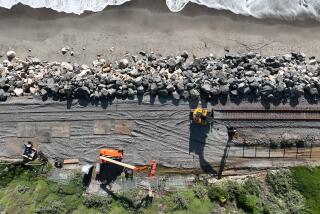Status-Conscious Neighbors Line Up to Build Stone Fences
- Share via
Durette Upton put one in. Then, two of her neighbors each wanted one. Soon, half a dozen more folks were considering it.
That’s how it’s going these days in rural Loudoun County, Va., a distant suburb of Washington, where dry stone walls--the low fences made of stacked stones that traditionally marked farm boundaries--are catching on again in a big way, particularly among newcomers who are turning old farms into their own small country estates.
“To me, it says Loudoun,” said Upton, a real estate broker who had a dry stone wall built at her Round Hill, Va., property, which prompted two of her neighbors each to get one. “It conjures images of horses and hunts. There is a certain cachet.”
Trouble is, there aren’t too many people who can build them anymore. Dry stone wallers, as they’re called, are a dying breed, and there are now no more than 10 in central and Northern Virginia, which has meant that remaining stone wallers are swamped with work.
“There ain’t too many of us around anymore, but there are sure a lot of people looking for one,” said Robert F. Richards, 78, who along with his son makes up one of only three stone walling businesses left in Loudoun County.
When he started in 1948, Richards said, he would fight for a job with as many as two dozen other wallers, craftsmen who stack stones so precisely and tightly that they last for years without any mortar or frame to support them. “Now I only know of maybe six or seven in the area,” Richards said, adding that some come in from West Virginia.
There is so much new work that customers will have to wait months to have a stone wall built or to have one restored, said Robert C. Richards, 38, who has been building stone walls for 24 years, about half as long as his father. Recently, the father and son team was working on three projects at once, and they are back to working year-round--except when it rains.
“We don’t work in the rain. We’re no ducks,” Richards said, as he spit out a wad of chewing tobacco.
Why the renaissance for stone wallers?
Many of the newcomers see the fences as a reminder of Loudoun’s rustic past and a symbol of status, county residents say. The walls cost four to five times more than wood fences and they’re fixtures of Loudoun’s million-dollar estates, such as Paul Mellon’s Rokeby Farm near Middleburg, Va.
“It’s definitely become a status symbol,” said Eugene Scheel, a local historian who has studied the history of stone walls.
The recent popularity of the walls intrigues historian Scheel, who noted they were built by farmers who just wanted to get the stones out of their fields.
During the Civil War, both armies used them as shields, Scheel added, noting that Loudoun has more of them than other parts of the state because the ground is so rocky.
To make the walls, “it’s like putting together a jigsaw puzzle,” said Richards, who says he has constant back problems but tries to ignore them. “Every rock will fit, but you’ve got to take your time to find the right piece.”
According to the Dry Stone Walling Assn. in Great Britain, where there are more than 70,000 miles of such walls, the typical craftsmen will lift six metric tons of stone to build a 12-foot stretch of wall.
More to Read
Sign up for Essential California
The most important California stories and recommendations in your inbox every morning.
You may occasionally receive promotional content from the Los Angeles Times.













